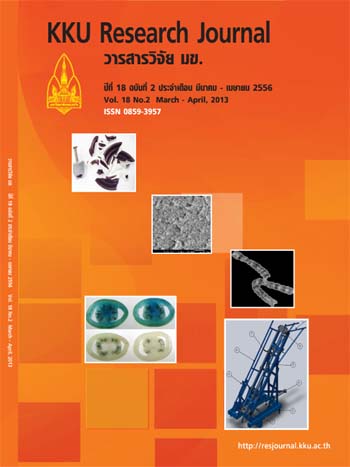Appropriate binder for titanium dioxide coating onto fluorescent lamps for microorganism removal from the air
Main Article Content
Abstract
In this study, titanium dioxide was mixed with binder which was polyethylene glycol molecular weight of 1,000 (PEG-1000) or polyvinyl alcohol (PVA) or Silane-69 in a concentration of 1% compared to 3% by weight of titanium dioxide (5% Degussa P25) and spray-coated onto fluorescent lamps. Each set of coated lamps (set of 3) was mounted in a 2 ? 2 ? 2 m3 chamber to study Escherichia coli removal capability. Bacteria were injected continuously into the chamber for 2 hours. In the first hour, E. coli concentration was sampled every ten minutes by using an impactor at the height of 1.5 m when the coated lamps were not turned on yet. In the second hour, the coated lamps were turned on and the sampling was continued in the same manner for a comparison. Also a comparison was made with the uncoated lamps and the binder coated (without titanium dioxide) lamps. All sets were repeated three times. Results revealed that when using the uncoated lamps, E. coli was removed 29%. When using only-binder-coating lamps, E. coli were removed 23-33% (depending on the type of binder). However, when the titanium dioxide plus 3%PEG coated lamps were replaced, the E. coli removal was the highest as 84%. With the binders of 3% PVA and 1%PVA, the E. coli removals were 71% and 69%, respectively, while 1%PEG showed the efficacy of 63%. However, the least efficacy was found from Silane-69, which 1% Silane-69 could remove 57% and 3% Silane-69 could remove 53%.
Article Details
How to Cite
Larpkern, S., Supothina, S., & Chuaybamroong, P. (2017). Appropriate binder for titanium dioxide coating onto fluorescent lamps for microorganism removal from the air. Asia-Pacific Journal of Science and Technology, 18(2), 270–279. retrieved from https://so01.tci-thaijo.org/index.php/APST/article/view/82845
Section
Research Articles

